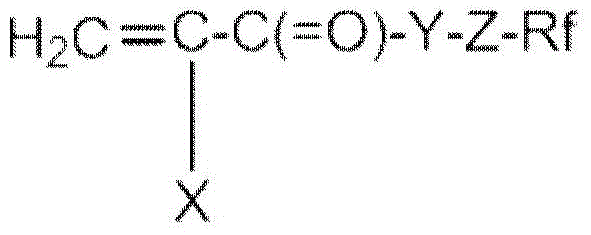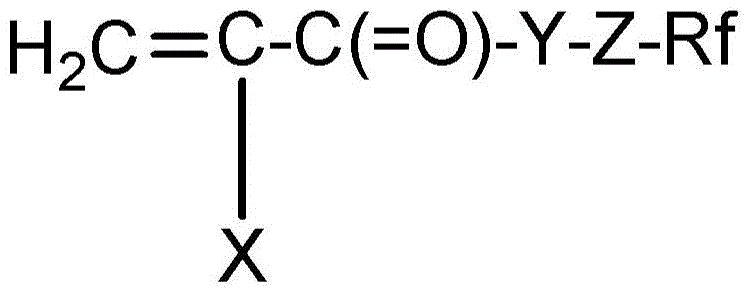water and oil repellent
A water-repellent, oil-repellent, fluorine-free technology, applied in textiles, papermaking, fiber treatment, etc., can solve problems such as poor water and oil repellency
- Summary
- Abstract
- Description
- Claims
- Application Information
AI Technical Summary
Problems solved by technology
Method used
Image
Examples
manufacture example 1
[0057] Production example 1, as shown in Table 3, 15 g of isobornyl acrylate (IBOA), 2 g of 2-methyl-2-acrylic acid-2,3-dihydrocarbyl propyl ester (GLA), 6 g of diacetone acrylamide (DAAM) , n-dodecanemercaptan (0.75g), 43.5g of dipropylene glycol methyl ether and 300g of deionized water were stirred at 50°C for 20 minutes, and a stable homogeneous emulsion was obtained by high-pressure homogenization under a pressure of 40MPa, using UV at a wavelength of 650nm Its penetration needs to be greater than 15%T. Put the high-pressure homogeneous emulsion into a 1L four-neck glass reaction bottle, add 0.8g of 2,2'-azobisisobutylamidine dihydrochloride, 45g of vinylidene chloride (VDC), and react at 60°C for 6 hours , to obtain an aqueous dispersion of fluorine-free polymers. The above-mentioned aqueous dispersion of fluorine-free polymers was mixed in a ratio of 3 into Comparative Example 1 to obtain an aqueous dispersion of fluorine-containing and fluorine-free hybrid polymers.
manufacture example 2
[0058] Manufacturing Example 2, as shown in Table 3, stearyl acrylate (SA) 15g, glycidyl methacrylate (GMA) 2.5g, diacetone acrylamide (DAAM) 6g, n-dodecyl mercaptan (0.75g ), 43.5 g of dipropylene glycol methyl ether and 300 g of deionized water were stirred at 50° C. for 20 minutes, and homogenized under high pressure at a pressure of 40 MPa. Put the high-pressure homogeneous emulsion into a 1L four-neck glass reaction bottle, add 0.8g of 2,2'-azobisisobutylamidine dihydrochloride, 45g of vinylidene chloride (VDC), and react at 60°C for 6 hours , to obtain an aqueous dispersion of fluorine-free polymers. The above-mentioned aqueous dispersion of fluorine-free polymers was mixed in a ratio of 3 into Comparative Example 1 to obtain an aqueous dispersion of fluorine-containing and fluorine-free hybrid polymers.
manufacture example 3
[0059] Manufacturing example 3, as shown in Table 3, perfluorooctyl alcohol methacrylate (6FMA) 75g, isobornyl acrylate (IBOA) 15g, glycidyl methacrylate (GMA) 2.5g, diacetone acrylamide (DAAM) 6g, n-dodecanemercaptan 0.75g, dipropylene glycol methyl ether 43.5g and deionized water 300g were stirred at 50°C for 20 minutes, and homogenized under high pressure at 40MPa. Put the high-pressure homogeneous emulsion into a 1L four-neck glass reaction bottle, add 0.8g of 2,2'-azobisisobutylamidine dihydrochloride, 28g of vinylidene chloride (VDC), and react at 60°C for 6 hours , to obtain an aqueous dispersion of acrylic polymer. Mix Comparative Example 2 in a ratio of 3 into the above-mentioned aqueous dispersion of acrylic polymers to obtain an aqueous dispersion of fluorine-containing and non-fluorine hybrid polymers.
PUM
| Property | Measurement | Unit |
|---|---|---|
| diameter | aaaaa | aaaaa |
Abstract
Description
Claims
Application Information
 Login to View More
Login to View More - R&D
- Intellectual Property
- Life Sciences
- Materials
- Tech Scout
- Unparalleled Data Quality
- Higher Quality Content
- 60% Fewer Hallucinations
Browse by: Latest US Patents, China's latest patents, Technical Efficacy Thesaurus, Application Domain, Technology Topic, Popular Technical Reports.
© 2025 PatSnap. All rights reserved.Legal|Privacy policy|Modern Slavery Act Transparency Statement|Sitemap|About US| Contact US: help@patsnap.com



